From the Archives ...
Trout tips - from tackle shops
Presented from Issue 105, August 2013
We did a bit of a runaround Tasmania’s tackle stores to see what their tips for the first month or so of the tackle season were. We asked what the top three places to fish were, plus lures, flies, baits and a few other things.
Here is a rundown on their answers Whenever, and wherever you fish - anywhere, or for any fish in the world - ask the locals and especially ask at the local tackle store. They know what was caught today, yesterday and on what.
Please check all relevant authorities before fishing - www.ifs.tas.gov.au and dpipwe.tas.gov.au . Don't forget issuu.com/stevenspublishing for years of back issues !
Tasmania recently hosted, Kirk Deeter, a leading US angling journalist and widely travelled author. Here is what he had to say in a recent social media post about his experience.
"Thank you, Tasmania.
Just back from one of the most extraordinary "fishing" trips I've ever experienced. Never thought I'd watch a wallaby jump over the creek as I made a cast. Never thought I'd see 7-pound brown trout tailing like redfish in skinny water, crushing frogs in the grasses. Never imagined a hatch of snowflake caddis that made the river look like an impending blizzard. Under-appreciated the significance of Tasmania in a cultural and historic context... as this is where the empire of the brown trout first expanded beyond European shores. Didn't fully respect just how dialed Tassie anglers are in terms of their cutting-edge techniques. Had almost forgotten what a truly wild trout behaves like, and how awesome it is to watch them eat a fly.
Did NOT under-appreciate the amazing hospitality and stunning environs while I was there.
Much, much more forthcoming, but worth saying that Tasmania is beyond special. Love NZ, and Chile, and Argentina, and of course, the wild, wild West of America. But for context, know that Tassie sold a grand total of @250 fishing licences to foreign anglers last year... by contrast, NZ sold about 100 times that many.
In other words, it's wide open.
More soon... just landed... totally spent... feel like Dorothy waking up after her trip to Oz."
- Written by Stephen Smith - Rubicon Web and Technology Training
- Category: IFS, DPIPWE, MAST and Peak Bodies
- Hits: 1288
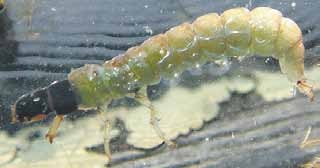 |
| Free living Caddis larva Family Hydrobiosidae) |
The Peeping Stick Caddis
Presented from Issue 117, August 2015
Caddis larva are very high on trouts’ diet. They come in two forms, those that build portable homes (Stick Caddis) and free living. All caddis larva have a hardened section near and including the head, whilst the bodies are soft and range in colour from off white through to a dirty yellow and green in a variety of shades. They also have claws to cling onto the inside of their portable case. Caddis can be found in water from fast flowing streams to marshlands and lakes. Case building caddis use leaves, sticks, reeds or spun silk as a home. These are generally found in slow moving or still waters: others use sand or very small stones and these are normally found in streams.
- Written by Stephen Smith - Rubicon Web and Technology Training
- Category: Tackle, Boats and other Equipment
- Hits: 5454
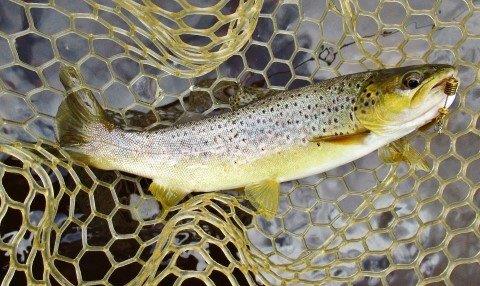 Headed off around 8:00 am for a spin session in the river this morning only to find the river was running a little on the high side and it wasn't safe enough for me to cross over. That's what I get for not checking the river levels before I left home. I decided to head on up to the upper reaches of it where I knew it was safe enough to hop in and wade. This is when it's handy knowing the rivers I fish so after so many years of fishing in them, one gets to know them like the back of your hand. I headed to one of my favourite areas only to find someone else already in the river fishing which meant I had to fish elsewhere.
Headed off around 8:00 am for a spin session in the river this morning only to find the river was running a little on the high side and it wasn't safe enough for me to cross over. That's what I get for not checking the river levels before I left home. I decided to head on up to the upper reaches of it where I knew it was safe enough to hop in and wade. This is when it's handy knowing the rivers I fish so after so many years of fishing in them, one gets to know them like the back of your hand. I headed to one of my favourite areas only to find someone else already in the river fishing which meant I had to fish elsewhere.
- Written by Stephen Smith - Rubicon Web and Technology Training
- Category: Mersey River
- Hits: 1867
Read more: Great spin session with the Aglia Furia - 30/11/2018
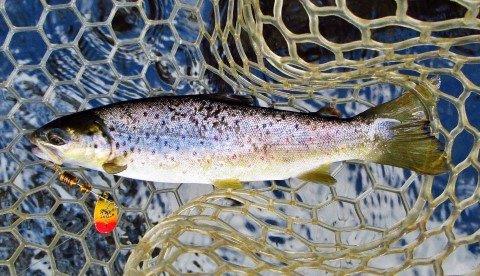 Another overcast and windless morning saw me in the Meander River by 7:20 am when I started casting the Mepps Aglia Furia up & across the river. Using the cast & drift method it was on the second cast that I had a follow from a medium size brown. Even though it didn't take the s[inner it was a good sign seeing a trout so early into the spin session. The river height was running at 62 cms which was fine for where I was fishing at this stage, though I would have preferred it to have been five to ten centimetres lower.
Another overcast and windless morning saw me in the Meander River by 7:20 am when I started casting the Mepps Aglia Furia up & across the river. Using the cast & drift method it was on the second cast that I had a follow from a medium size brown. Even though it didn't take the s[inner it was a good sign seeing a trout so early into the spin session. The river height was running at 62 cms which was fine for where I was fishing at this stage, though I would have preferred it to have been five to ten centimetres lower.
- Written by Stephen Smith - Rubicon Web and Technology Training
- Category: Meander River
- Hits: 1769
Read more: Great start on the trout, before it slowed to a crawl - 19-11-18
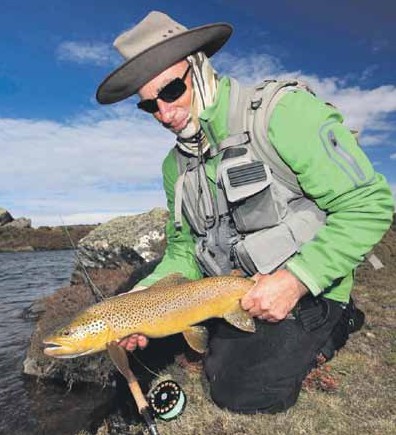 Presented from Issue 117, August 2015
Presented from Issue 117, August 2015
Dry fly or wet fly
I like catching fish on a dry fly just as much as the next person and will often persist with floating flies early in the season, experimenting to try for a response, . I know that I will get refusals and catch less doing this, but for me this is not a numbers game.
Success or failure with any fly can vary from water to water in the Western Lakes, as each location can be vastly different from the next. What fish feed on can change from lake to lake or from shore to shore depending on the make up of each lake, the food within it and the effects of rising or falling water levels. The trick is to find a fly and technique that will trigger a response from them more often than not. Sometimes it comes down to finding a single fish that is willing to take a chance and open and close its mouth onto a fly that vaguely resembles a potential feed.
- Written by Stephen Smith - Rubicon Web and Technology Training
- Category: Western Lakes
- Hits: 3745
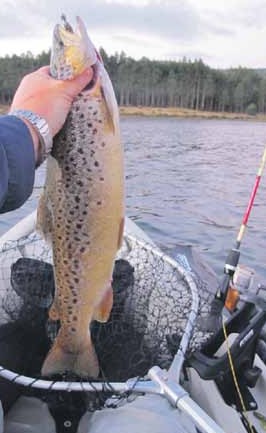 |
| Sometimes getting one in the boat can be a challenge. |
Presented from Issue 117, August 2015
For those of you who love to trout fish, there will have been a time, some stage during your fishing ‘career’, where you lucked out and didn’t catch anything! Most of you will also know that in the ‘fishing world’, this is what is commonly known as a ‘donut’! It is the same shape as a zero of course. Now while the usual ‘donut’ means that no fish were caught, it doesn’t mean that there were no missed takes or bites. While this might seem bad at the time, there is something worse. That something is the ‘big fat donut’. This is where you go a whole day and don’t even get a sniff!
Iwill be brave here and admit to having taken home many ‘donuts’ during my time as a trout angler. I have also done the same during a bream competition some time back; however, given that it is the start of a new season, our focus here will be on trout. There are many factors that can influence the feeding behaviour of trout, with weather a significant one. While rain, or any other form of precipitation such as snow or hail, does not make for enjoyable fishing, such weather events do require the presence of clouds, and cloudy conditions generally mean good fishing conditions.
- Written by Stephen Smith - Rubicon Web and Technology Training
- Category: Trout Fishing
- Hits: 2232
Read more: Dodging the Donut - Strategies that work - Mik Rybka
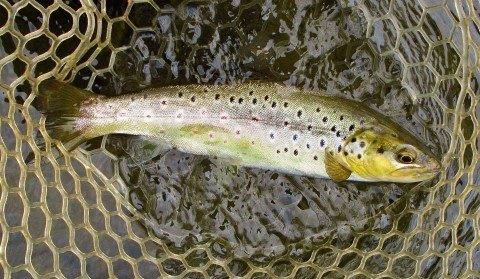 Perfect weather conditions for trout fishing today saw me head to the upper reaches of the Mersey River chasing the trout. It was a dull overcast day with a light shower of rain every now & then, it couldn't have been a better days for chasing trout. The area I headed to is probably one of the toughest to get to and also not the easiest on the body either.
Perfect weather conditions for trout fishing today saw me head to the upper reaches of the Mersey River chasing the trout. It was a dull overcast day with a light shower of rain every now & then, it couldn't have been a better days for chasing trout. The area I headed to is probably one of the toughest to get to and also not the easiest on the body either.
The river bottom is always slippery, even worse the rocks roll under foot making it so hard when wading up the river. Just staying upright in the river is a bonus. In saying that, the fishing has been great for the majority of trips I've had here, it can also have it's off days too. Those off days are usually when the river is low and clear with full sun on it. Today is the ideal day to fish this area, it's in these humid, damp conditions when this area fishes really well. I arrived at 7:50am then headed off to the river,I started fishing just after 8:30am.
- Written by Stephen Smith - Rubicon Web and Technology Training
- Category: Mersey River
- Hits: 2140
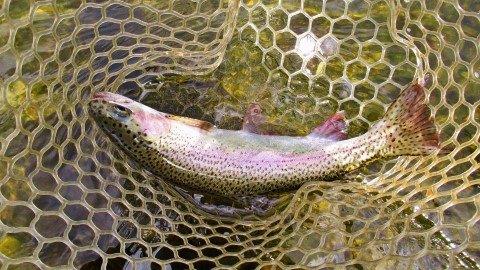 A gusty Easterly wind was forecast as the day went on so I hit the Mersey River just after 8:00 am in what was a lovely morning with overnight fog lifting and no wind to worry about for now. I spotted several trout on the rise in a wide open stretch of water which was a good sign. Seeing them on the rise meant there were a few insects around, so I'm hoping the fishing may improve here at last. I started of using a #1 Mepps Aglia TW Streamer spinner, mainly because it has a small fish like streamer attached to the main body.
A gusty Easterly wind was forecast as the day went on so I hit the Mersey River just after 8:00 am in what was a lovely morning with overnight fog lifting and no wind to worry about for now. I spotted several trout on the rise in a wide open stretch of water which was a good sign. Seeing them on the rise meant there were a few insects around, so I'm hoping the fishing may improve here at last. I started of using a #1 Mepps Aglia TW Streamer spinner, mainly because it has a small fish like streamer attached to the main body.
- Written by Stephen Smith - Rubicon Web and Technology Training
- Category: Mersey River
- Hits: 1724
Read more: Trout fishing a little better in the Mersey - 14/11/2018
![]() The Maria Island Zone (between Cape Forestier and Marion Bay) will remain closed when the east coast rock lobster season opening occurs on 8 December for the recreational fishery and 11 December 2018 for the commercial fishery.
The Maria Island Zone (between Cape Forestier and Marion Bay) will remain closed when the east coast rock lobster season opening occurs on 8 December for the recreational fishery and 11 December 2018 for the commercial fishery.
Results from rock lobster samples collected from this Zone on 20 November show that biotoxins remain at unacceptable levels – above the regulatory limits.
Although biotoxin levels detected in sentinel mussel samples along the east coast have been at negligible levels for some time, PST levels in lobster in the Maria Island Zone have not declined to within the regulatory limits from the harmful algal bloom (HAB) in that Zone during the closed season.
The Maria Island Zone will remain closed until biotoxin levels are below the prescribed levels.
Additional sampling will be undertaken and a decision on the open/closed status for this zone will be made just prior to the weekends of 15/16 December and if necessary 22/23 December.
ALL OTHER ZONES WILL OPEN AS PLANNED - More information here

- Written by Stephen Smith - Rubicon Web and Technology Training
- Category: IFS, DPIPWE, MAST and Peak Bodies
- Hits: 2248
With East Coast Stock Rebuilding Zone waters opening on Saturday 8 December, it's time to check that your rock lobster licence is up to date. Recreational licences for abalone, rock lobster, scallops, nets and set lines are now on sale at Service Tasmania and online.
Get ready for the new season by picking up a free rock lobster measuring gauge from Service Tasmania. You can check up on catch limits and other rules using the Recreational Sea Fishing Guide or on our website.
- Written by Stephen Smith - Rubicon Web and Technology Training
- Category: IFS, DPIPWE, MAST and Peak Bodies
- Hits: 1709
Subcategories
Current TFBN
Click above for current issue content. The current issue of TFBN is extensive and topical. In Tackle Stores, Newsagents and by subscription.
Delivered to your door for $48 for 2 years (8 issues). To subscribe, send Mike $48 via www.paypal.com.au . (Basic instructions are here) The email is at Contact Us. Your address will be included from PayPal.
Or phone Mike with your c/c handy on 0418129949
Please ensure your details are correct, for Mike to organise delivery.
TFBN Newsletter Sign up Form
Why not submit an article ?
When you have finished for the day, why not have a brag about the ones that didn't get away! Send Mike an article on your fishing (Click here for contact details), and we'll get it published here. Have fun fishing - tasfish.com
Category Descriptions
Here is a list of all of the Article Categories. The number in Brackets, eg (13) is the number of articles. Click on Derwent River and all articles relating to the Derwent will be displayed in the central area.
Articles by Category
-
Rivers (3)
-
Saltwater and Estuary Fishing (149)
-
Kayak Fishing (34)
-
Lakes (1)
-
Great Lake (62)
-
Lake Leake (52)
-
Woods Lake (16)
-
Lake Augusta (11)
-
Huntsman Lake (13)
-
Lake Pedder and Gordon (10)
-
Lake Dulverton (5)
-
Lake Crescent (6)
-
Tooms Lake (10)
-
Lake Mackintosh (2)
-
Lake Barrington (5)
-
Little Lake (8)
-
Meadowbank Lake (5)
-
Lake King William (7)
-
Lake St Clair (2)
-
Western Lakes (12)
-
Arthurs Lake (35)
-
Lake Echo (7)
-
Four Springs (54)
-
Lake Sorell (7)
-
Lake Burbury (6)
-
Other Lakes (57)
-
Brushy Lagoon (18)
-
Little Pine Lagoon (5)
-
Penstock Lagoon (16)
-
Brumbys Creek (7)
-
-
Events (48)
-
Estuary Fishing (0)
-
Coastal Catches (46)
-
Super Trawler (46)
-
IFS, DPIPWE, MAST and Peak Bodies (435)
-
Commercial Interests (98)
-
Other (24)
-
TFBN Back Issues (8)
-
Fly Fishing (67)
-
Trout Fishing (252)
-
Meteorology and Weather (8)
-
Jan’s Flies (50)
-
Tuna Fishing and other Game Fishing (86)
-
Cooking Fish (19)
-
Fishing Information (1)
-
Fishing Books (8)
-
Videos (5)
-
Tackle, Boats and other Equipment (146)
-
World Fly Fishing Championship 2019 (2)
Popular Tags
windyty.com
Visit https://www.windyty.com/
Rubicon Web and Technology Training
Hello everyone, I thought it would be a good time to introduce myself.
My name is Stephen Smith and I have been managing the website tasfish.com since May 2009.
It has been an epic journey of learning and discovery and I am indebted to Mike Stevens for his help, support and patience.
I am developing a new venture Rubicon Web and Technology Training ( www.rwtt.com.au ). The focus is two part, to develop websites for individuals and small business and to train people to effectively use technology in their everyday lives.
Please contact me via www.rwtt.com.au/contact-me/ for further information - Stephen Smith.
From the Archives ... (last chance)
Tiny creeks and sea run trout - Christopher Bassano
Presented from Issue 105, August 2013
Christopher Bassano fishes over 250 days a year. This interview was recorded just before he headed off to fish for Australia in the World Fly Fishing Championships in Norway 14-17 August 2013.
I live on a small stream and at the start of the season I like to go off on a bit of a discovery mission and fish the headwaters of the creeks and rivers I feel an affinity with.
These small rivers include the St Pats, Meander, Forester, Little Forester and others. The further up you go on these rivers the clearer and lower the levels. They are often less affected by the rain and runoff and you get some good opportunities. Get as close to the source as you can and you will find some good dry fly fishing. Don’t limit yourself to those I have mentioned. Most headwaters will hold trout.
Read more ...


